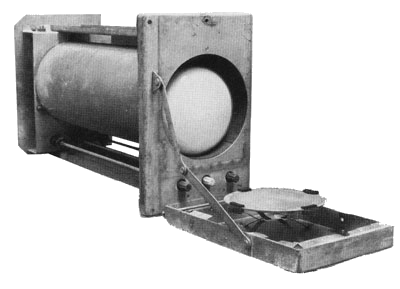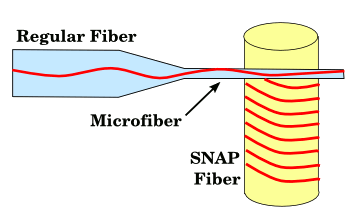Optical Memory
January 6, 2012
Early
computers were lacking in one important piece of hardware, and that was
memory. Quite a few novel memory devices were fielded before the advent of
ferrite core memory. One of the most interesting was the
Williams tube, the first commercial
random-access memory device. It stands to reason that
vacuum tube computers would use a vacuum tube for memory, but in this case the vacuum tube was a
cathode ray tube (CRT).
The
electron beam of a CRT will deposit a
charge into its
phosphor screen that eventually dissipates, but it will store a data signal for a short time. A
metal plate, placed over the face of the CRT, acts as a plate of a
capacitor. The electron beam, when it rescans the data area, completes the capacitor circuit, and a
voltage signal can be read to identify the data. The read is destructive, so the area must be refreshed after reading.

A Williams tube computer memory, capable of holding about a thousand bits. The plate that's pressed against the tube surface can be seen.
(Via Wikimedia Commons))
The next advance in computer memory devices was the
mercury delay line memory, which was used in the
Univac I computer.[1-3] Data were stored as a recirculating
sound wave in a container of
mercury. Mercury was a good choice for a medium, since the
speed of sound in a
liquid is proportional to ρ
-1/2, where ρ is the
density. Mercury has a very high density (about 13.5
g/
cc), and its speed of sound is about 1450
m/
s.
A meter long tube of mercury would hold a thousand bits, about the same as for a Williams tube, and these bits would recirculate in less than a millisecond. The Univac I memory had ten units of eighteen tubes each, so its total storage capacity was 10x18x1000 = 180,000 bits, or 22,500 eight-bit
bytes (22.5 kB). The serial data rate for such a memory was about 22.5
MB/sec.
There were advances in the art of delay line memory based on
magnetostriction, sound waves circulating in crystal plates, and electromagnetic waves in
coaxial cable and
microstrip transmission lines. One of my colleagues even built a
magnetostatic delay line memory device, based on other work he had done with magnetostatic wave devices,[4] as a demonstration project.
The essential problem with all such delay line memories was their serial aspect, so accessing your data was slow compared with random access memory types. Random access memory was expensive compared with delay line memory, so a
cost-benefit analysis was needed for specific applications. Now, inexpensive
semiconductor memory gives us random access to our data at very high data rates.
I mentioned
whispering gallery modes for trapping light signals in a
previous article (Resonant Light Conversion, December 14, 2011). Whispering galleries are delay lines for light signals, and they can be used for data storage just like the other delay line systems described above.
Scientists from
OFS Laboratories,
Somerset, New Jersey, a
Bell Laboratories spin-off, have developed a novel method of using a whispering gallery mode in
optical fibers to form light storage regions and chaining these together to make a data storage array. Their method, as described in a recent issue of
Optics Letters, sends light in a corkscrew path along the surface of an optical fiber, rather than down its center.[5-6]
Light signals enter this corkscrew trajectory in a prepared fiber through
evanescent coupling from another fiber, arranged perpendicular to the first, and tapered to confine the light to a small region (see figure). The corkscrew trajectory means that the light travels down the fiber at a much lower speed than it would if it were traveling a straight line in the core, so delay is enhanced and more information can be stored.

It's all done with mirrors - a gradient index mirror, that is.
An evanescent wave is coupled from a tapered optical fiber into the SNAP fiber.
(Illustration by the author, via Inkscape)
Instead of storing data in one long delay line, it's possible to tap the corkscrew delay line at intervals to allow reading portions of the data. The OFS Laboratories scientists have demonstrated a chain of ten optical fiber corkscrew microresonators.[6] They've called their fabrication method, Surface Nanoscale Axial Photonics (SNAP).[5-6]
SNAP uses uses
CO2 and
UV excimer lasers to heat the fiber to a
temperature below its
melting point, but above a point at which the internal
stress, typically induced in the fiber during its manufacture, is
annealed out.[5] This changes the
refractive index and fiber diameter in a small region to enable the corkscrew light channel. Says Misha Sumetsky, lead author of the Optics Letters paper,
"This annealing allows us to change the radius in this nanoscale range. In the new system, the accuracy of the fiber radius variation is about 0.1 angstrom - orders of magnitude better than achieved before."[6]
The process accuracy in reforming the fiber radius is better than two
angstoms (0.2 nm).[5]
References:
- John Presper Eckert, Jr. and John W. Mauchly, "Memory System," US Patent No.2,629,827, February 24, 1953.
- UNIVAC I Mercury Delay Line Memory Tank, Computer History Museum.
- 1951 UNIVAC I Mercury delay line Memory Tank, YouTube Video, Computer History Museum, December 22, 2007
- Herman van de Vaart, Hugh B. Matthews and James C. Worley, "Acoustic Delay Surface Wave Motion Transducers," US Patent No. 3,863,497, February 4, 1975.
- M. Sumetsky, D. J. DiGiovanni, Y. Dulashko, J. M. Fini, X. Liu, E. M. Monberg, and T. F. Taunay, "Surface nanoscale axial photonics: robust fabrication of high-quality-factor microresonators," Optics Letters, vol. 36, no. 12 (December 15, 2011), pp. 4824-4826.
- Angela Stark and Sherry Salyer, "Optical Fiber Innovation Could Make Future Optical Computers a ‘SNAP'," Optical Society of America Press Release, December 14, 2011.
- OFS Laboratories Web Site.
Permanent Link to this article
Linked Keywords: Computers; computer_memory; ferrite core memory; Williams tube; random-access memory; vacuum tube; cathode ray tube; electron beam; charge; phosphor; metal; capacitor; voltage; bit; Wikimedia Commons; mercury delay line memory; Univac I; sound wave; mercury; speed of sound; liquid; density; gram; g; cubic centimeter; cc; meter; m; second; s; byte; Megabyte per second; MB/sec; magnetostriction; coaxial cable; microstrip; transmission line; magnetostatic; cost-benefit analysis; semiconductor memory; whispering gallery; OFS Laboratories; Somerset, New Jersey; Bell Laboratories; spin-off; optical fiber; Optics Letters; evanescent coupling; Inkscape; CO2 laser; UV excimer laser; temperature; melting point; stress; annea; refractive index; angstom; US Patent No.2,629,827; US Patent No. 3,863,497.